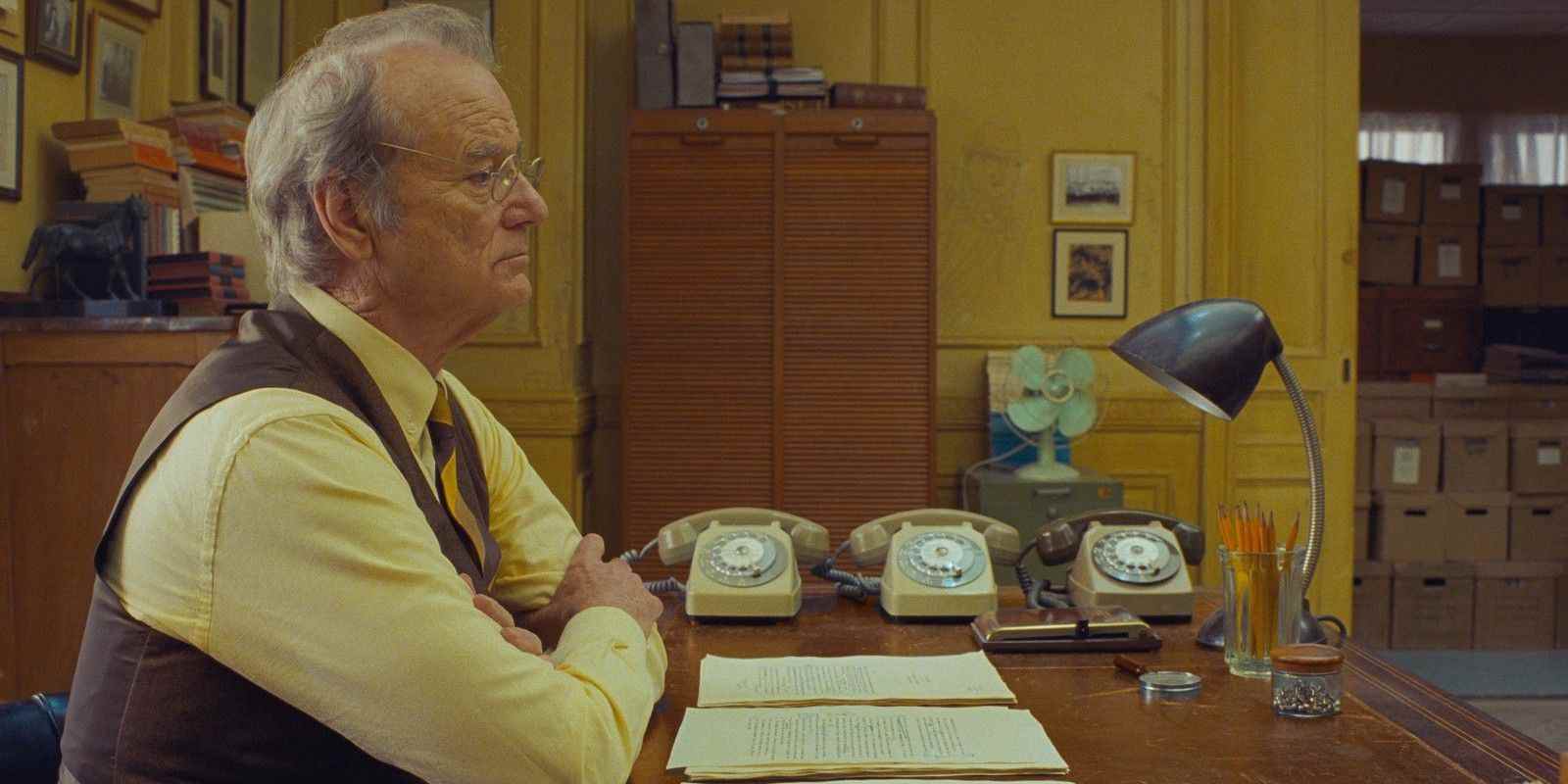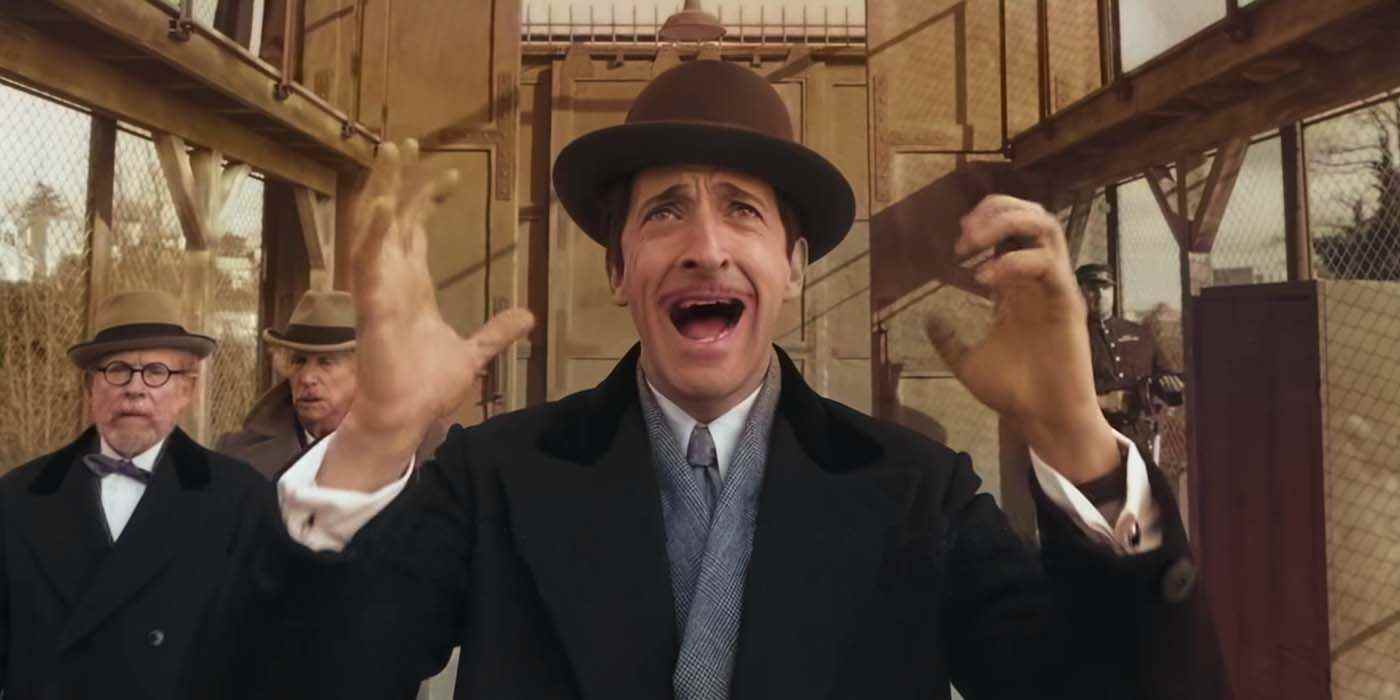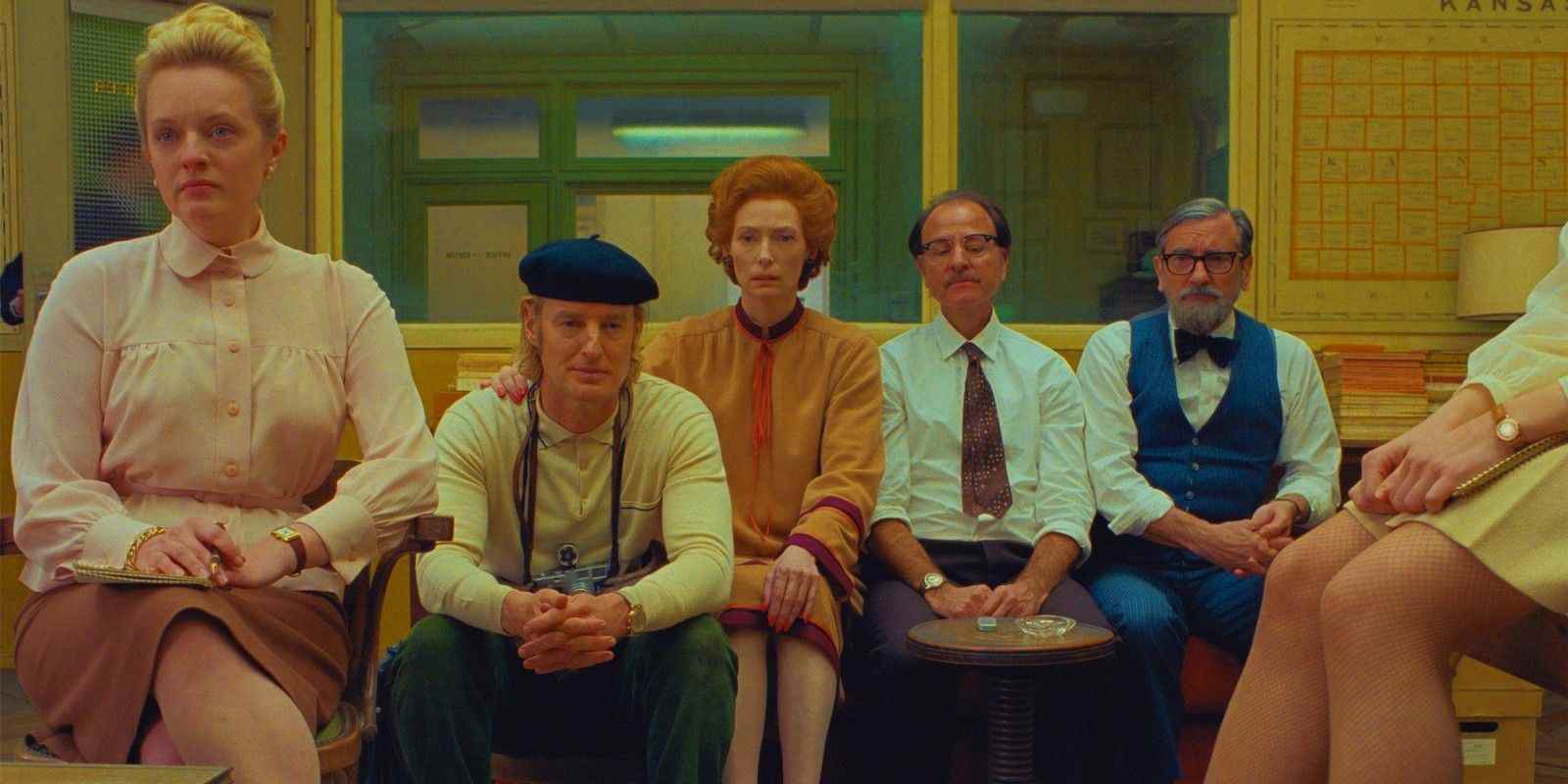The French Dispatch ending cements Wes Anderson’s tribute to journalism of days past. The narrative structure didn’t land with all film critics, but others celebrated Anderson’s ingenuity in truly capturing the big-screen feeling of a 1960s-era magazine issue. This isn’t the first movie in which Wes Anderson has paid tribute to certain media types and pursuits of past eras, such as his critically divisive 2004 film The Life Aquatic With Steve Zissou, serving as a love letter to oceanography and the work of Jacques Cousteau. Anderson has been described as one of the most literary directors in the modern film landscape, so it’s no surprise The French Dispatch takes on the most literary structure of his films since 2001’s The Royal Tenenbaums.
The 2021 movie has also been described by critics and fans as the most Wes Anderson movie to date; however cliché the description is, it’s not incorrect. The French Dispatch is Wes Anderson at his most nostalgic, his most technically enhanced, and the quirkiest conception of his characters. It’s also a cartoonish ode to French culture that many have compared to his tribute to Japanese culture in the movie Isle of Dogs, though the latter film was also criticized for fetishization. On the contrary, The French Dispatch is an Americanized version of quaint France, following expatriate journalists who settle their Kansas publication in the fictional French town of Ennsui-sur-Blasé. Nonetheless, French pop culture is heavily interspersed throughout The French Dispatch, with subtle French phrases, tributes to great 1960s directors like Truffaut, and inclusions of bygone French singers. It also doesn’t seem coincidental that Anderson recruited Timothée Chalamet, a half-French-American, as one of the movie’s stars.
While the eponymous French Dispatch publication is fictional, Wes Anderson’s movie is grounded in real-life inspirations for both the articles in the publication as well as the writers behind the stories. Iconic writers for The New Yorker or similar syndicates are used as models for Anderson’s quirky scribes, such as Bill Murray’s character emulating Harold Ross or Jeffrey Wright’s role taking from the highly revered revolutionary James Baldwin. Wes Anderson doesn’t miss an opportunity to reveal his longing for publications like The New Yorker before he was even born, and The French Dispatch uses nostalgic switches between color and black-and-white cinematography to invite the viewers to explore a past era of journalistic artistry. From The French Dispatch ending feeling melancholy yet hopeful to the stories explored in each magazine section, the film is a beautiful tribute to a bygone form of artistry.

Unsurprisingly, The French Dispatch as a whole is a tribute to journalism, particularly The New Yorker. The mixed reviews of The French Dispatch noted its clunky structure as part of why it didn’t land with all audiences, but its uneven separation of stories is completely intentional. The movie plays as a silver screen edition of a magazine, flowing through the magazine’s about info, the short travel section, a long exposé for the arts section, a political piece that is also omits any real politics, an adventurous chef profile-turned-kidnapping caper interspersed with the magazine’s comic strip imagery support, and a final obituary about The French Dispatch’s revered editor. Anderson is already known for unconventional film structures, and The French Dispatch takes its oddities to a higher level. Aside from paying tribute to the writers who took up such a profession in journalism’s heyday, Anderson’s movie enhances its homage by arranging its narrative structure ala magazines. The literary arrangement also calls back to Anderson’s The Royal Tenenbaums, which was structured a novel in chapters telling the story the dysfunctional, genius family.

Outside of the journalists retelling their stories for The French Dispatch’s final issue, the opening and closing sections that show the journalists gathered in the pressroom is Anderson’s clearest tribute to the writers behind the magazines. The movie’s pressroom opening features a voiceover by Wes Anderson’s frequent collaborator Angelica Huston, following the day in which The French Dispatch’s editor Arthur Howitzer, Jr. (Bill Murray) suddenly dies of a heart attack. The pressroom gathers to read his will, which states that the publication of The French Dispatch will end following one final issue, which will include three past stories from the paper and an obituary to Anderson’s Bill Murray character. The section clearly serves as a callback to the heyday of print journalism, with a pressroom comradery and almost chaotic energy of getting the publication prepared and stories finalized. Just as The New Yorker’s magazine supremacy is long gone, this era in print journalism is as well. Now, publications are fighting for the most clicks or subscription prices as they work from their laptops. The long-gone feeling of sophisticated magazine pursuits is a nostalgic look at what Anderson grew up reading and admired, which sadly doesn’t exist in the same art form today.
The pressroom obituary in The French Dispatch ending isn’t just a goodbye to the movie’s fictional publication, but a longing thank you to an exciting era in print journalism. The French Dispatch serves as a tribute to and ghost story of magazines and publications like The New Yorker, an art form that doesn’t exist in the same manner today. The New Yorker today may be seen as a ghost of its past era under Harold Ross that Anderson is so nostalgic for, and it would have been all the more upsetting had Anderson included a vignette of newsrooms today. Nostalgia is the most common theme across Wes Anderson’s movies, and its presence in The French Dispatch most closely aligns with the familial arrested development of his characters in The Royal Tenenbaums. In how he bookends The French Dispatch with Howizter’s fictional passing, Anderson essentially suggests The New Yorker’s classic era died for him with Harold Ross.

The shortest section of The French Dispatch features Owen Wilson as Hersaint Sazerac, the magazine’s travel writer. Riding his bicycle around The French Dispatch’s fictional Ennui-sur-Blasé, Sazerac’s article reveals the beauties and tragedies in a small French city. The cats that occupy the town’s roofs, the sudden spring to life of the town in the morning, the prostitutes on the corner, and the architectural beauty, not leaving out any of what makes it special nor what makes it a real tormented city. Wilson’s section is what most clearly calls back to Anderson’s previous movies that explore specific locations. The New York City landscape of The Royal Tenenbaums and Austria-inspired Grand Budapest Hotel feature heavy looks at the settings of the stories and their specific Andersonian style. The French location of The French Dispatch isn’t simply coincidental, it’s Anderson’s tribute to the nation and the daily lifestyle of its small towns in the 1960s era.

Out of the five sections that Wes Anderon’s movie is separated by, the one that has received the most praise is “The Concrete Masterpiece.” The piece is written by The French Dispatch journalist J.K.L. Berensen (Tilda Swinton), following the artist Moses Rosenthaler (Benicio del Toro), who is imprisoned in a jail/asylum for murder, as he paints abstract portraits of prison guard Selina. Julien Cadazio (Adrien Brody), a former inmate and art dealer, seeks to buy and sell Rosenthaler’s paintings even at the artist’s protests. Rosenthaler’s pieces soon become an art sensation, though it isn’t long before Cadazio and his art enthusiast colleagues demand more from the painter. After years of struggling with inspiration, Rosenthaler paints extravagant pieces that wow the other dealers, though they happen to be painted on the walls of the prison. Adrien Brody’s character then removes the entire concrete wall so that it able to be seen elsewhere, sold, or replicated.
It’s clear that Rosenthaler is the hero in the arts section of The French Dispatch’s issue – a literally and figuratively tortured artist who sits in prison for murders that he did knowingly commit. He may be a murderer, but his talents continue to be exploited for the capital gain of others that he will never see. His form of revenge is crafting his masterpieces on a concrete prison wall that doesn’t conform to the commodification of his work, leading to a fight between Rosenthaler and Cadazio that quickly switches been color and black-and-white. Anderson’s The French Dispatch is a love letter to art, and the piece on the imprisoned artist is a clever way for him to explore the exploitation of craft. Rosenthaler is already in an exploitative prison, and his human rights are stripped away even further when others seek to take the only slice of personal autonomy he has left and commodify it. He’s not in a place to say no to Cadazio, and the art dealer knows that, leaving Rosenthaler even more helpless with his art than he was before entering prison.
It’s also poignantly upsetting when Anderson’s section goes through how the dealer attempted to create a story and exhibition based on Rosenthaler’s progression of art throughout his life. The Benicio del Toro character’s most recent abstract paintings have acquired a massive following, and the pieces that are arguably his best and most self-expressive have the least appreciation. The piece that clearly stands out is the self-portrait of his mental illness painted by himself at a young age (portrayed by The Grand Budapest Hotel’s Tony Revolori), and it’s the final piece shown with only one ardent supporter. He’s also a tortured artist in that his muse for his abstract pieces is a prison guard, with their relationship calling back to H.I. and Ed’s prisoner-guard romance in the Coen brothers’ Raising Arizona. It’s quite ironic that Adrien Brody’s character is set on the capitalistic gains and exploitation of del Toro’s art when his Grand Budapest Hotel character’s core conflict surrounded retrieving the priceless Boy With Apple painting.

One of the most anticipated sections of The French Dispatch was that involving young Hollywood star Timothée Chalamet, who portrays a teenage revolutionary named Zeffirelli in 1968 France. The fast-paced politics piece features a voice-over by the article’s writer, Lucinda Krementz (Frances McDormand), who seeks to provide an in-depth look at the young revolutionaries and specifically Zeffirelli writing his manifesto. The section brings up an important aspect of journalism that continues to plague the industry, with Krementz asserting herself too closely into the piece by seducing Zeffirelli, proofreading his manifesto, and contradicting her journalistic integrity and ethics. The section may seem odd when Zeffirelli chooses between an affair with Krementz or romance with his revolutionary comrade, but it’s actually based on a real-life journalist, revolutionary figure, and movement from a French town in 1968.
The “Revisions of a Manifesto” section and The French Dispatch‘s young characters are an absurdist take on the May 1968 revolts in France led by young people striving for greater freedom under a highly conservative president. The French youth was becoming fed up with the overwhelming orders and restrictions of society, and students at the campus of the University of Paris at Nanterre began protesting by occupying administration buildings. The young people didn’t want much, which is what much of The French Dispatch is absurdly parodying, as their “political demands” were more focused on being able to spend nights in each other’s dorms (via NPR). By May 1968, more campuses around France protested in support of Nanterre, which saw numerous students arrested for their occupations. The French police had brutally beaten and jailed the protesting students, even though their revolution was more culturally and socially based than politically charged. There wasn’t really a chess game between a young revolutionary leader and the police as Searchlight Pictures’ movie depicts, though it seems to be more symbolic of the tactics and back-and-forth maneuvers by each side.
Not only does the youth revolution come from a real historical event, but the journalist and the magazine’s article is also based on the real-life writings of Mavis Gallant, who served as the inspiration for Frances McDormand’s character. Gallant had written a two-part article titled “The Events in May: A Paris Notebook” for The New Yorker in 1968, who was right in the trenches with the student revolutionaries. Just like Frances McDormand’s The French Dispatch character, Gallant’s article featured herself as a character amidst the action, viewing the revolution as a fairly unwelcome outsider.

The section pays tribute to the artistry of food and one’s passion as much as it does about how tortured a writer/journalist can be themselves. Jeffrey Wright’s movie character’s declaration that he is a quite forgetful person but has a typographic memory appears to symbolize how much writers can criticize or be racked with their own work. It’s a common trope among writers to be able to remember every word they’ve ever written, remembering how one could have changed a simple word or sentence to make it better, yet forget larger events of daily life. He’s writing about a talented local Ennui-sur-Blasé chef, though the chef becomes largely forgotten by the time the piece is written. The chef’s talent and tribute to his artistry are summarized in the one line that the journalist wanted to leave out of his piece – bittersweetly finding new flavors and a novel experience in a radish he made with poison. As such, the section of The French Dispatch is focusing far more on the art of journalism and a creative person’s craft than it is about the chef he’s supposed to be profiling.
Similar to “The Concrete Masterpiece” being a retelling by the journalist at a seminar, “The Private Dining Room of the Police Commissioner” is retold by the writer during a 1970s-like talk show interview. Even more than “Revisions of a Manifesto,” the food section of The French Dispatch’s final issue is focusing on the journalist themselves at a higher rate than the literary subject, which points to another issue of journalistic integrity in which the writer is not supposed to be part of the story they’re crafting. Since Wes Anderson’s film is also a tribute to the quirky creatives behind the stories, it’s no surprise he integrates them into the article’s retelling at an unusual rate. This section specifically is geared at paying tribute to the great writer James Baldwin, and the intonations of Jeffrey Wright’s character as well as what he chooses to include or omit in his stories reflect the genius of Baldwin.
The French Dispatch’s story also reveals how harrowing a journalist’s simple pursuit can turn. Wright’s character had simply intended to eat a meal made by the chef at the police commissioner’s home, only for it to turn into an exciting kidnapping caper in which the journalist was documented the police’s attempt to retrieve Gigi, the commissioner’s young son. While the chef only has a few moments of screen time in The French Dispatch, he is still seen as the hero of the story, cooking the food that poisons the kidnappers and saves young Gigi. The symbolism of the chef feeling such bliss in a new flavor from a poison also tries to convey the upsetting nature of an artist’s work, in which the journey to find one’s masterpiece can also mean fatal repercussions.

Overall, Wes Anderson is paying tribute to a bygone era of journalism and the art of crafting such a lovable publication. Anderson gives equal focus to the writers of the articles and the artists they’re profiling. Each figure the journalists are writing about are considered artists, and Anderson paints them each as the heroes of their own stories. Benicio del Toro’s character is the focus of The French Dispatch’s second main article, a painter whose work is being exploited by an art dealer while he serves a prison sentence for murder. As a type of payback to Adrien Brody’s character, the artist paints his long-awaited work on the prison’s concrete walls, making it nearly impossible to be taken away and commodified. After stopping a prison riot during the gallery showing of his paintings, Rosenthaler is released from prison on probation, now having more freedom and control over his own work. This section is Anderson highlighting the artistry of a creative painter and the journalist who is working with the art dealer and covering his story.
This tribute continues with the revolutionary manifesto piece, with the young character played by Timothée Chalamet being an artist of his political craft, serving as the face of the youth revolution. Similar to the chef in the next piece, Chalamet’s character dies in the pursuit of his dream, risking his life for his contributions to a message he helped craft. Just like the Frances McDormand’s The French Dispatch scribe, Ziffirelli is an artist for his writing and how he can tell a story in a manifesto that moves his readers and inspires conversation among other revolutionaries. Even more so, the final food section piece is centered on a James Baldwin-esque journalist who is tasked with profiling a notable Ennui-sur-Blasé chef. Roebuck Wright is as equally the hero of the piece as the chef who cooks the meal that saves the child (until Ed Norton’s character drives off with Gigi). To Roebuck, his writing is his art and being able to reach an audience with his words is his pursuit, just like the chef is pursuing the perfect meal and flavor. The chef’s artistry is the food he makes, and Roebuck’s love of writing about food will undeniably make the well-regarded chef the story’s hero. The old-school pressroom and magazine publications of the Harold Ross era are a lost art today, and Wes Anderson nostalgically writes The French Dispatch ending (and the whole film) as his love letter to the journalists’ craft and the artistic figures that they editorialize.
